On October 13 and 14, the National Governors Association, in partnership with the Office of South Carolina Governor Henry McMaster, hosted an Electric and Alternative Fuel Vehicle Infrastructure Summit in Greenville, South Carolina. This event brought together leaders from 30 states and territories, federal partners and private sector practitioners to discuss electric and alternative fuel vehicle infrastructure siting and delivery, federal funding opportunities and state/territory best practices. Governors’ advisors engaged with in-depth panels and had the opportunity to network with colleagues, federal representatives and practitioners over the two-day event.
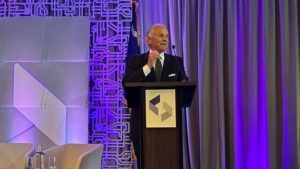
The Summit opened with remarks from South Carolina Governor Henry McMaster, who highlighted South Carolina’s well-established automobile manufacturing industry, which includes BMW, Mercedes, Volvo, and electric bus manufacturer Proterra. He said that South Carolina is well-suited to transform manufacturing toward electric vehicle (EV) production, and that some manufacturers operating in the state are already moving in that direction. Governor McMaster announced the signing of Executive Order 2022-31, which established an Electric Vehicle Coordinator and created an Interagency EV Working Group within the state, noting that “communication, collaboration and cooperation” are key to success in this sector.
Eight panel sessions were held over the course of the two-day convening, covering a range of EV and alternative vehicle infrastructure issues. Below is a summary of each of those panel sessions.
Day 1 Sessions
National Electric Vehicle Infrastructure Overview and Federal Resources
This panel, which was moderated by Justin Powell with the South Carolina Department of Transportation, provided attendees with the opportunity to hear from federal officials on EV and alternative fuel vehicle charging infrastructure funding opportunities.
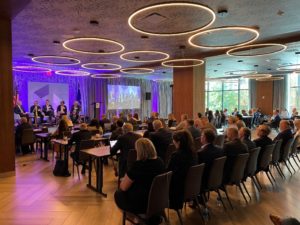
During the discussion, Alex Schroeder, Chief Technology Officer with the Joint Office of Energy and Transportation, noted that National Electric Vehicle Infrastructure (NEVI) plans were recently approved for all states, D.C. and Puerto Rico, and that these jurisdictions had been allocated the initial tranche of funding from the bipartisan Infrastructure Investment and Jobs Act (IIJA) NEVI program. Andrew Rogers, Chief Counsel with the Federal Highway Administration, discussed how NEVI funding will be used to build out the electric vehicle network “backbone” along the national road network, and that forthcoming IIJA discretionary funds will allow for states to identify and address charging gaps in rural communities and urban areas. Yvette Taylor, Regional Administrator with the Federal Transit Administration, highlighted other federal electrification programs, including funding for electric school and transit buses. Similarly, Karl Simon, Director of the Transportation and Climate Division at the U.S. Environmental Protection Agency, noted the popularity of the Clean School Bus program that recently closed for applications, along with the Diesel Emissions Reduction Act (DERA) Program.
The Zero-Emission Economy: Perspectives from Industry on Alternative Fuel Vehicles and Infrastructure in Goods Movement
Cole Mortensen with the Nevada Department of Transportation moderated a panel on electric and alternative fuel infrastructure for freight and goods movement with Jeff Cleland from Amazon, Jay Collins from WEX, Rich Mohr from ChargePoint and Robert Wimmer from Toyota.
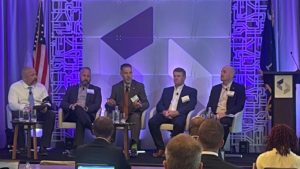
During this session, panelists observed that the transformation to low- or no- emission fleets may not be a one-size fits all approach. Amazon ‘s Jeff Cleland highlighted the company’s goal of having a no-emission fleet by 2050 and noted that EV fleet adoption is easier for last-mile transportation than for middle-mile goods movement. Toyota’s Robert Wimmer said that heavy-duty trucks present a great opportunity for hydrogen fuel cells and that Toyota has successfully tested class 8 hydrogen fuel cell-electric trucks for port drayage in Los Angeles.
On the topic of fleet management, Rich Mohr with ChargePoint emphasized the need to think through electric vehicle fleet adoptions to ensure that integration is as smooth as possible and is consistent with how companies operate. Jay Collins with WEX discussed how the charging experience matters, including access, security and ease of charging payments for drivers.
Working with Utilities on Energy Generation and Distribution Needs for Charging Infrastructure
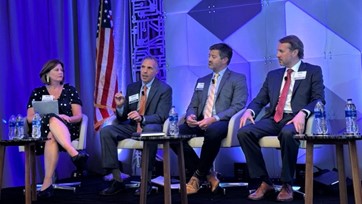
Danny Kassis with Dominion Energy, Corey Gordon with Duke Energy and John Frick with the Electric Cooperatives of South Carolina discussed the role of electricity distribution systems to support charging infrastructure with discussion leader Anne Blair with the Electrification Coalition.
Panelists spoke about the importance of state and utility collaboration and information sharing to create the best path to electrification. The panel talked through the role of utilities as a supporter and enabler of the transition to EVs and emphasized the importance of ensuring that rural areas receive their share of service at a reasonable cost. The panel also touched on the critical issue of grid capacity to absorb the growth in electricity demand from the adoption of EVs. Specifically, speakers discussed optimizing existing infrastructure and aligning regulatory structures with transportation electrification, such as through time-of-use rates for charging and other demand-side tools to keep costs at bay, as well as using public-private partnerships to help solve capacity issues.
State Initiatives to Deploy EV Infrastructure
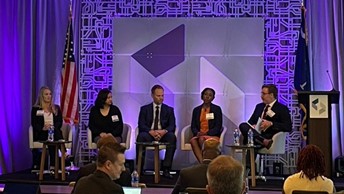
Day 1 of the Summit rounded out with a showcase of state best practices in electric and alternative fuel infrastructure planning and deployment, which was moderated by David Peters with the American Association of State Highway and Transportation Officials (AASHTO).
During the panel, each participant provided highlights of their state’s work in deploying EV infrastructure. Trevor Pawl, Michigan’s Chief Mobility Officer, discussed the state’s collaboration with Illinois, Wisconsin and Indiana to create the Lake Michigan Electric Vehicle Circuit, a signature tourist route supported by a network of charging stations around Lake Michigan. He also discussed other efforts being pursued in Michigan, including a Wireless EV charging road system in Detroit and a review of the state’s policy framework related to EV infrastructure. Illinois’ State Electric Vehicle Officer, Megha Lakhchaura, emphasized the state’s focus on working across different agencies to achieve EV goals, as well as the work being undertaken to ensure Justice40 communities benefit from federal programs. Andrea Hopkins, Associate Administrator at the Arkansas Department of Energy and Environment, discussed ongoing collaboration across agencies and highlighted that the state is developing pricing guidance for utilities to encourage equitable charging rates for those in underserved or rural communities. Joy Johnson, EV Program Manager at the Louisiana Department of Transportation, talked about Louisiana’s Clean Fuels Committee, which has been established to coordinate across agencies and highlighted that Louisiana has been focused on preparing its request for proposals and expects this to be open for bids in January.
During the discussion, all panelists reflected on how their states are focused on workforce development to ensure there is the right workforce available to deploy EV and alternative fuel vehicle infrastructure. Panelists discussed the role of apprenticeship and partnering with local community colleges and other providers to develop the right training programs for the future.
Day 2 Sessions
Charging Infrastructure: Siting for All
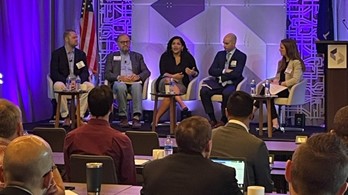
Day 2 of the Summit kicked off with a deeper exploration into the siting of electric and alternative fuel infrastructure to achieve equity goals. The panel was moderated by Rebecca Gould with McKinsey, and comprised Minelly De Coo with New York, Patrick Murphy with Vermont, Dan Wilson with Inspiration Mobility and Phil Jones with the Alliance for Transportation Electrification.
Panelists emphasized the importance of setting ambitious EV infrastructure accessibility goals and then setting an agenda to implement. This process can involve using data to understand current conditions and needs across the state, the location of target communities and the charging behavior of residents. It also requires an understanding of the different pots of money available to achieve goals and those agencies that need to be involved in deployment. Speakers addressed how federal funding opportunities will likely not be sufficient to achieve equity goals and that private capital and utilities should be leveraged to support the transition. Equity goals can also be promoted through partnering with underserved communities to meet workforce development goals for the deployment of EV infrastructure.
Charging Infrastructure: Rights of Way
This panel continued on the theme of EV infrastructure siting with a focus on rights of way along highways. This panel was moderated Adrian Rouse with Deloitte and included Lynne Yocom representing Utah, Audrey Alstom with the Alaska Energy Authority, Allie Kelly with The Ray and Andrew Bui with AECOM.
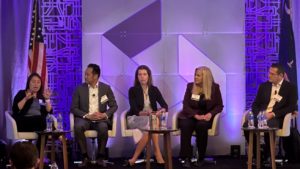
The importance of rights of way and rest stops in support of EV and alternative fuel vehicle infrastructure deployment was a key theme of this panel. Panelists noted that states and territories should consider leveraging available property and supporting infrastructure and that rights of way should be incorporated in EV planning at the outset. The discussion turned to possible issues with leveraging rights of way, including the need to modernize codes, safety considerations and permitting processes. The role of creating partnerships with private investors, utilities and telecommunication providers was also discussed.
Charging Infrastructure: Delivery Options
As states and territories commence the deployment of EV and alternative fuel vehicle infrastructure, the issue of procurement and delivery opportunities is now at the forefront. This panel discussed deployment issues with discussion leader Megha Lakhchaura, State Electric Vehicle Officer, Office of Illinois Governor JB Pritzker.
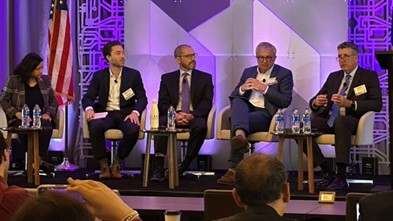
During the discussion, Lawrence Slade, Executive Director of the Global Infrastructure Investor Association, emphasized the large amount of private capital available to support the deployment of EV infrastructure. He observed that states should consider distinguishing between those locations that the market can serve without financial assistance and funnel federal funding toward other locations where it may not be viable for the market to operate. Vince Cubbage, Interim CEO at Volta Charging, discussed Volta’s business model of generating revenue from screen advertising on EV charging stations, with cross-benefits of lower or free charging rates for drivers. Opportunities for the private sector to support states with longer-term operating and maintenance costs of chargers following deployment of NEVI funds was highlighted by Joshua Cohen with Shell Recharge Solutions. Zachery Karson with the infrastructure advisory and investment firm Rebel Group discussed his firm’s collaboration with the Federal Highway Administration to provide technical advice to states and territories on EV and alternative fuel vehicle infrastructure deployment. He said that Rebel can support states with innovative procurement, including bidder selection, contract negotiation and transaction implementation.
Integrating Charging Infrastructure with Energy, Broadband and Intelligent Transportation System Solutions
The final panel of the Summit concluded with a 30,000-foot discussion on integrating charging infrastructure and the future of mobility. Panelists included Secretary Julie Lorenz, Governor’s Infrastructure Coordinator and Secretary of Transportation for Kansas; Katherine Keith, Change Management Director, Alaska Department of Transportation and Public Facilities; Sajid Khan, General Manager Business Development and Marketing at Intel; and Oscar Llama, Business Development Manager at Schneider Electric.
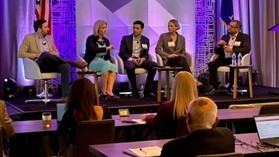
Panelists emphasized the need to have a vision and think big to take advantage of transformational opportunities in the electric and alternative fuel vehicle infrastructure space. Echoing national cooperation and coordination, the panel noted the vision needs to be grounded in what the community wants. Communities need to be in the driver’s seat through ongoing input and collaboration with public and private partners. This ensures that everyone is moving in the same direction. To achieve a state’s vision, systems must work together and there must be both collective and individual work led by states and territories. Additionally, we must seek solutions that have a horizontal approach. Hardware and software partners must also work collaboratively to deploy a combination of physical and digital infrastructure to achieve transformational goals. Reaching holistic approaches as such means we need to plan upfront. Although we cannot predict the future,we can plan for the future.
Like much of the event, the concept of thinking big, starting small and moving fast was a major theme throughout this final panel.
Contributors: Tom Curtin, Dan Lauf, Richard Lukas, Glenn Grimshaw, Badiki Ebenja and Evan Blankenberger












